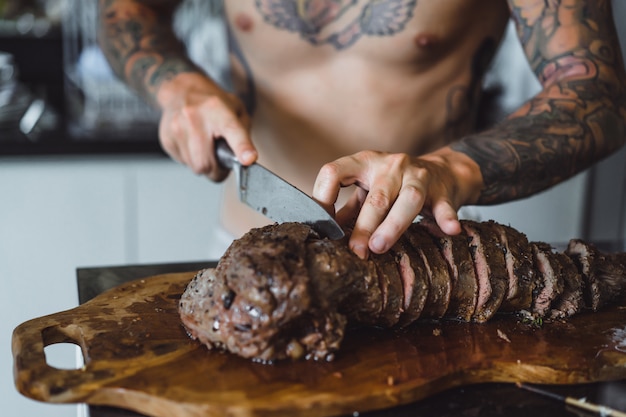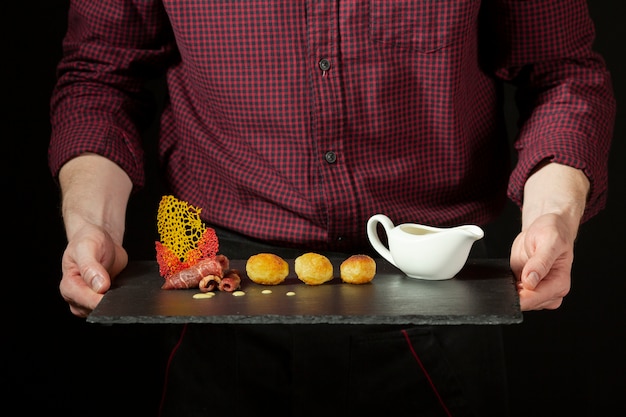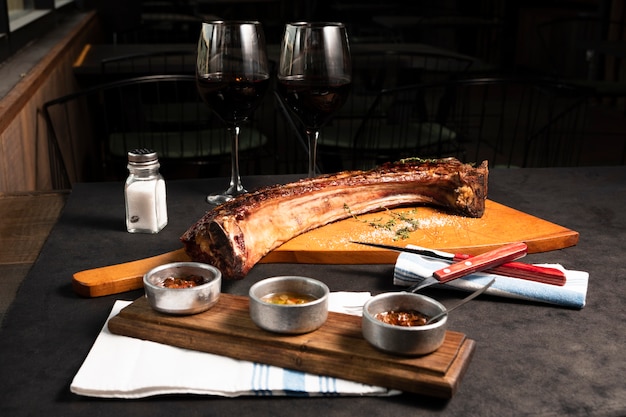Let's talk roast beef, but not just any old roast beef. I'm talking about the kind that makes your taste buds sing, the kind that melts in your mouth like butter, the kind that brings back fond memories of Sunday dinners with your family. The kind of roast beef that leaves you feeling utterly satisfied and craving seconds. This isn't just a recipe; it's an adventure, a journey towards a culinary masterpiece. I'm here to guide you through the ins and outs of crafting the perfect roast beef, sharing my own experiences and tips along the way.
You see, I've been cooking for ages, and let me tell you, I've had my share of roast beef disasters. From tough, chewy cuts that felt like they were chewing back, to dry, flavourless roasts that would have made even a hungry dog turn its nose up, I've experienced it all. But through trial and error, I've finally cracked the code. And now, I'm ready to share my hard-earned wisdom, so you can avoid the pitfalls and create a truly memorable roast beef experience.
We'll delve into the world of choosing the right cut of meat, mastering the art of seasoning, and navigating the different cooking methods. We'll also explore the delightful accompaniments that elevate your roast beef to another level, turning it into a true culinary triumph. So grab your apron, sharpen your knives, and get ready for a roast beef adventure that will leave you wanting more!
Part 1: The Quest for the Perfect Cut

The Stars of the Show
Let's get down to brass tacks: the cut of meat. This is the foundation of your roast beef masterpiece, so choosing the right one is crucial. Now, there are a few prime suspects that always deliver on flavour and tenderness. When I want to really impress, I usually go for either a rib roast or a sirloin roast.
A rib roast, also known as a standing rib roast, is a true classic for a reason. It's got this beautiful marbling of fat that melts during cooking, creating an incredibly tender and flavourful meat. It's also a showstopper on the table with its impressive size and bone-in presentation. Just picture it – a majestic roast, glistening with a golden crust, surrounded by its delicious accompaniments. It's a culinary spectacle!
On the other hand, a sirloin roast is a bit more lean, but still packs a punch when it comes to flavour. It's perfect for those who prefer a slightly less fatty roast and is often more affordable than the rib roast. You can opt for a top sirloin or a bottom sirloin, depending on your preference and budget. Both offer a delicious and satisfying roast.
The Underdogs
Don't think that the rib and sirloin roasts are the only contenders. There are other options out there, each with its own unique characteristics. chuck roast, for instance, is a tougher, more economical cut that's ideal for slow cooking. It's a great option for those looking for a budget-friendly roast that still packs a punch. Just make sure to cook it low and slow to ensure it comes out tender and juicy.
Then there's the tenderloin roast, also known as a filet mignon, a lean and flavourful option that's always a crowd-pleaser. It's perfect for those who prefer a leaner, more delicate roast. But be warned, it's often more expensive than other cuts.
The Ultimate Decision
In the end, the choice is yours. It truly comes down to personal preference and what you're looking for in your roast beef. If you're looking for the ultimate indulgence, go for a rib roast. If you prefer a more lean and economical option, a sirloin roast will do the trick. And if you're feeling adventurous, try exploring the world of chuck roast or tenderloin roast. There's a perfect cut out there for everyone.
Part 2: The Magic of Seasoning

The Essential Trinity
Now that we've chosen our cut, it's time to delve into the art of seasoning. This is where the real magic happens. A simple yet effective seasoning can transform your roast beef from ordinary to extraordinary. My go-to trinity for seasoning roast beef is salt, pepper, and garlic powder.
Salt is the key to drawing out moisture and creating a flavorful crust. Don't be shy with the salt; use a generous amount. Pepper adds a touch of heat and complexity, while garlic powder adds a wonderful aroma and depth of flavour. These three simple ingredients work together to create a harmonious blend of flavours that will make your roast beef truly unforgettable.
Beyond the Basics
But don't feel limited by the basics. If you want to get a little fancier, you can add other herbs and spices to your seasoning mix. I often like to add a sprinkle of dried thyme or rosemary for a touch of earthy flavour. It's a subtle addition that complements the meat beautifully. And if you're feeling adventurous, you can even add a pinch of paprika or cayenne pepper for a bit of spice. Just remember, a little goes a long way. It's all about finding the balance that suits your taste.
The Timing is Key
Here's a little tip: season your roast beef liberally at least an hour before you cook it. This gives the salt time to penetrate the meat, drawing out moisture and creating a more flavorful and tender roast. It's a simple step that makes a big difference.
Part 3: cooking techniques: Mastering the Craft

The Oven: A Classic Approach
Alright, let's talk about cooking methods. There are two main ways to cook your roast beef: in the oven or on the grill. I prefer the oven method, as I find it gives the most consistent results. It's also a lot less fuss than trying to keep an eye on a hot grill. Plus, you can use the oven to cook your accompaniments at the same time, making it a more efficient way to cook.
To oven-roast your beef, start by preheating your oven to 325°F (160°C). Place your seasoned roast beef on a roasting rack set inside a baking pan, allowing the air to circulate around the meat. This ensures even cooking and helps create a crispy crust.
Now, here's where things get interesting: cooking times can vary depending on the size and thickness of your roast. A general rule of thumb is to cook your roast beef for 15-20 minutes per pound at 325°F (160°C). However, to ensure your roast is cooked to your desired level of doneness, it's essential to use a meat thermometer. For medium-rare, aim for an internal temperature of 130°F (54°C). For medium, aim for 140°F (60°C). And for well-done, aim for 160°F (71°C).
The Grill: A Smoky Delight
If you're feeling adventurous, you can cook your roast beef on a grill. Just make sure your grill is nice and hot, preheating it for at least 10 minutes. Then, sear your roast beef on all sides over high heat for about 5 minutes, or until you get a nice crust. This will give your roast beef a delicious smoky flavour.
After searing, reduce the heat to medium-low and cook your roast beef for 15-20 minutes per pound, or until it reaches your desired level of doneness. Use a meat thermometer to check the internal temperature, as the cooking time may vary depending on the size and thickness of your roast.
The Importance of Resting
Once your roast beef is cooked, don't be tempted to slice it right away. Instead, let it rest for at least 15 minutes before carving. This allows the juices to redistribute throughout the meat, resulting in a more tender and flavourful roast. It's a simple but crucial step that elevates the final product.
While the roast beef is resting, you can tent it with aluminum foil to keep it warm and moist. This will help to prevent the meat from drying out.
Part 4: Accompaniments: A Culinary Symphony
The Classic Companions
Now that your roast beef is cooked to perfection, it's time to assemble the supporting cast: the accompaniments that complete this culinary symphony. First, you need a good gravy, a rich and flavourful sauce that perfectly complements the roast beef.
A classic Yorkshire pudding is also a must-have. These fluffy, golden-brown puddings are the perfect vehicle for soaking up all the delicious gravy and juices. They add a delightful texture and a touch of indulgence to your meal.
And no roast beef meal is complete without some roasted vegetables. Carrots, potatoes, parsnips, and Brussels sprouts all pair beautifully with roast beef, adding a touch of sweetness and earthiness to the meal. They add a vibrant pop of colour and a range of flavours that complement the richness of the roast beef.
A Touch of Creativity
Don't be afraid to get creative with your accompaniments. You can add a side salad for a touch of freshness, or serve your roast beef with a creamy horseradish sauce for a bit of tang. These additions add a layer of complexity and variety to your meal.
And for a truly special touch, try serving your roast beef with a dollop of cranberry sauce or a side of mashed sweet potatoes. These sweet and tangy additions contrast beautifully with the richness of the roast beef, creating a delicious and balanced meal.
Part 5: The Art of Carving: A Culinary Ballet
The Perfect Slice
The roast beef is resting, your accompaniments are ready, and it's time to carve. This is where a sharp knife comes in handy. A dull knife will result in uneven and ragged slices, so invest in a good carving knife that will make the carving process smooth and effortless.
If you're working with a bone-in roast, start by carving the meat away from the bone. Then, slice the meat against the grain. This will result in tender and juicy slices that melt in your mouth.
A Picture-Perfect Presentation
You can present your carved roast beef in a variety of ways. A classic approach is to arrange the slices on a platter, alongside your accompaniments. You can also use a carving board, which allows for a more rustic presentation.
No matter how you choose to present it, make sure your roast beef is the star of the show. Arrange the slices attractively, and don't be afraid to use a bit of garnish to add a touch of elegance.
Part 6: The Leftover Magic: No Waste Allowed
Let's face it, there's bound to be some leftovers. But don't despair! Leftover roast beef is a culinary treasure. It's a blank canvas for your culinary creativity.
Leftover roast beef can be used in a variety of dishes, from sandwiches and salads to soups and stews. I love making a classic roast beef sandwich with some horseradish sauce and a dollop of mustard. It's a simple yet satisfying meal.
You can also use leftover roast beef to create a hearty beef stew, or add it to a salad for a satisfying lunch.
Don't be afraid to experiment and let your imagination run wild. The possibilities are endless! So don't throw away those leftovers, embrace them and get creative in the kitchen.
Part 7: The Roast Beef Blueprint: Your Culinary Guide
Ingredients
- 1 (3-4 pound) boneless rib roast or sirloin roast
- 2 tablespoons kosher salt
- 1 tablespoon freshly ground black pepper
- 1 teaspoon garlic powder
- 1 tablespoon olive oil (optional)
Instructions
- Preheat oven to 325°F (160°C).
- Season the roast beef liberally with salt, pepper, and garlic powder. If desired, rub the roast with olive oil for a crispier crust.
- Place the roast beef on a roasting rack set inside a baking pan. This allows for even cooking and helps to create a crispy crust.
- Roast the beef for 15-20 minutes per pound, or until it reaches your desired level of doneness.
- Use a meat thermometer to check the internal temperature:
- Medium-rare: 130°F (54°C)
- Medium: 140°F (60°C)
- Well-done: 160°F (71°C)
- Let the roast beef rest for at least 15 minutes before carving. This allows the juices to redistribute throughout the meat, resulting in a more tender and flavorful roast.
- Serve with your favorite accompaniments.
Part 8: FAQs: Your Roast Beef Guide
Q: What's the best way to tell if my roast beef is done?
A: The most reliable way to tell if your roast beef is done is to use a meat thermometer. Insert the thermometer into the thickest part of the roast, making sure it doesn't touch any bone.
Q: How long should I roast my beef for?
A: A general rule of thumb is to roast your beef for 15-20 minutes per pound at 325°F (160°C). However, cooking times can vary depending on the size and thickness of your roast, so it's always best to use a meat thermometer to check the internal temperature.
Q: What's the best way to keep my roast beef moist?
A: The key to keeping your roast beef moist is to avoid overcooking it. Use a meat thermometer to check the internal temperature, and let the roast rest for at least 15 minutes before carving. This allows the juices to redistribute, resulting in a more tender and flavorful roast.
Q: Can I make my roast beef ahead of time?
A: Yes, you can definitely make your roast beef ahead of time. Just roast it as instructed, then let it cool completely. Once it's cool, wrap it tightly in plastic wrap and store it in the refrigerator for up to 3 days. To reheat, simply bring it to room temperature and then reheat it in a 325°F (160°C) oven for about 20 minutes.
Q: What's the best way to carve my roast beef?
A: The key to carving roast beef is to slice it against the grain. This will result in tender and juicy slices.
Part 9: The Roast Beef Legacy: A Culinary Tradition
Now, I'm not going to lie, making a melt-in-your-mouth roast beef takes some effort. But trust me, it's worth it. The aroma of roasting beef filling your kitchen, the satisfaction of carving that perfectly cooked beast, the happy faces of your family and friends… it's all part of a culinary tradition that's worth preserving.
So go on, embrace the challenge, and make your own roast beef legacy. You'll be amazed at what you can achieve. And remember, the journey is just as important as the destination. So enjoy the process, experiment, and have fun creating your own culinary masterpiece.
Everyone is watching

Perfect Rice Every Time: The Ultimate Guide to Cooking Rice
Cooking TipsAs a self-proclaimed foodie, I've always been a bit obsessed with rice. It's the foundation of countless cuisi...

Prime Rib Roast Cooking Time Chart: Per Pound Guide
Cooking TipsPrime rib roast. Just the name conjures images of lavish dinners, crackling fires, and hearty laughter. It’s ...

The Ultimate Guide to Cooking Asparagus: Tips, Techniques, and Recipes
Cooking TipsAsparagus. The mere mention of this spring delicacy conjures up images of vibrant green spears, crisp and burs...

Ultimate Guide to Cooking the Perfect Thanksgiving Turkey
Cooking TipsThanksgiving. Just the word conjures up images of overflowing tables laden with delicious food, the scent of r...

How Long to Bake Potatoes in the Oven (Perfect Every Time)
Cooking TipsBaked potatoes are a staple in my kitchen. They're incredibly versatile, delicious, and surprisingly easy to m...
